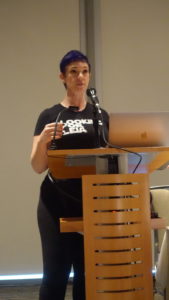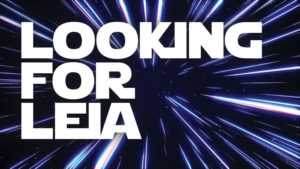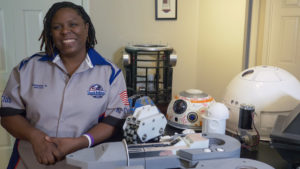On Saturday morning I had the great pleasure of being part of the conversation about women in fandom marshalled by documentary filmmaker Dr. Annalise Ophelian—the mighty force behind the upcoming fandom documentary Looking for Leia. Panelists included: Christina Cato, 501st Legion member and BB-8 builder; Pat Yolo, Assistant Jedi Temple Master and founder of the My Little Pony Jedi; Linda Hansen-Raj of Fangirl Blog; Maggie Nowalowska, an elder stateswoman of fandom and curator of early 80’s printed fanzines; and Jamala Henderson, a Seattle radio personality, newscaster, and lifelong fan (she can hum the entire soundtrack!).
Each of the women on the panel came to Star Wars at different times in their life and they focus and express their fandom in different ways but the one overriding theme of the panel and the morning was that Star Wars “has never been a boy thing”. Cato mentioned that she has more than once encountered male fans declaring “I’ve never met a girl who likes Star Wars as much as you.” Her deadpan reply: “Yes you have.”
It’s stories such as those that became the impetus for Dr. Ophelian, a professional documentary filmmaker, to explore the theme of women in fandom in her work. She talks about how “the fanboy narrative” has been thoroughly explored but it’s time for us, as women, to take our rightful place in fandom.
“Women were practically the core of Star Wars fandom in those days,” cites Nowalowska, referring to the years between A New Hope and The Empire Strikes Back. Although she allows, “there were some guys around.”

Dr. Annalise Ophelian addresses the crowd during the Looking for Leia panel at Geek Girl Con in Seattle
No one on the panel could be sure just when the shift happened that saw women relegated to the fringes of fandom in the face of a male takeover, but all agreed that it had been the cultural reality for some time. “When I want to hang out with a bunch of cis boys,” says Ophelian, “I’ll go to a con.” Jamala Henderson talked about a youth during which she was “alone with inner fandom” (and a few Timothy Zahn books), which bears a strong contrast to Maggie Nowalowska’s stories of women having “blaster battles in the hotels… before it was banned.”
The convention/group fandom realm wasn’t of particular interest to Dr. Ophelian, but that all changed when she attended Star Wars Celebration Anaheim in 2015. “I was taken aback by the number of women,” she recalls. She says: “it felt more like showing up fully, and being seen fully—then coming out as queer.” She wanted to document that experience.
Dr. Ophelian’s previous work has been primarily in the social justice arena. She brought up the concept of documentary as colonialism, and how it’s a rare thing that the subjects of Sundance-winning documentaries ever actually attend Sundance. She does what she can to push back against that. Looking for Leia, which Ophelian describes as “a joyous gender justice program” includes a collaborative editing process—with each subject able to review cut footage before it’s shown. Dr. Ophelian says it’s important to her that the documentary’s participants feel she “maintained the authenticity and accuracy” of what they had to say, and their messaged weren’t spun, skewed, or muddled in the cutting room.
The panel concluded with an exclusive sizzle reel featuring the women on the panel. Dr. Ophelian plans to make that footage available to the public soon.

Looking For Leia will continue to shoot in convention halls, at fan events, and in private homes through the end of 2017 and into 2018. For more information on the film, its participants, and how you can help, please visit www.lookingforleia.com or facebook.com/lookingforleia and follow @LeiaFangirlFilm on Twitter.


